Business Report: Nokia's Strategic Issues, Change Process, and Results
VerifiedAdded on 2020/10/05
|24
|8235
|333
Report
AI Summary
This report provides a comprehensive analysis of Nokia's strategic issues, focusing on the challenges the company faced that led to its decline in the mobile phone market. It identifies key issues such as the failure of the Symbian operating system, struggles in telecommunication advancements, and leadership problems. The report examines the rationale behind the need for change, including market trends and competition. It outlines the key stages involved in the change process, from acknowledging the need for change to communicating and engaging individuals. Furthermore, the report explores the strategic models applied and discusses the final outcomes of the change efforts. A reflective section is included, summarizing the key findings and lessons learned from Nokia's experience. The report highlights the importance of adapting to market changes, effective leadership, and innovation in the business landscape.
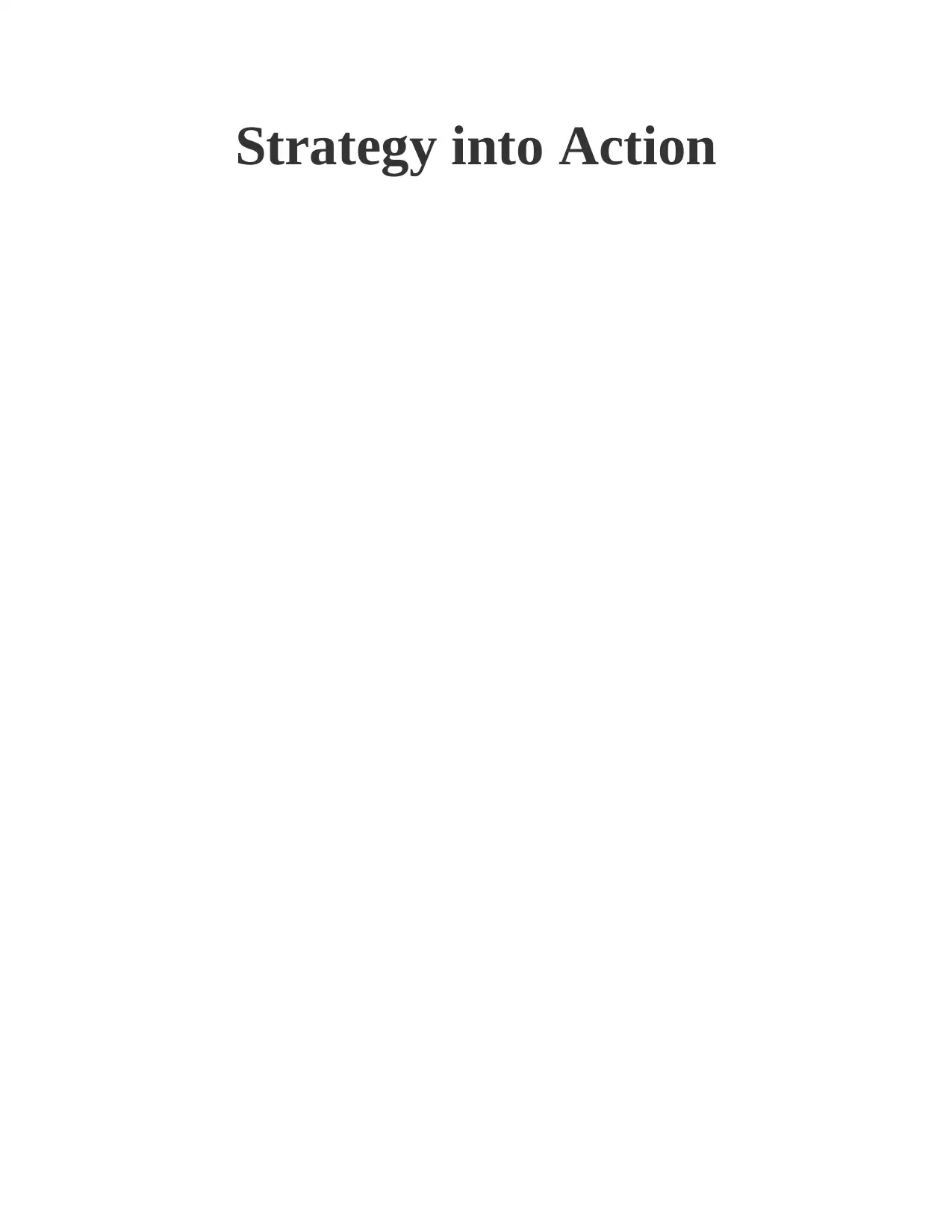
Strategy into Action
Paraphrase This Document
Need a fresh take? Get an instant paraphrase of this document with our AI Paraphraser

Table of Contents
INTRODUCTION...........................................................................................................................1
Identification of organization.................................................................................................1
Key strategic issues in the organization.................................................................................2
Rationale behind the initiation of the change process............................................................6
Key stages involved in the change process............................................................................6
Challenges in the change process ........................................................................................10
Strategic models ..................................................................................................................10
The end result.......................................................................................................................13
Part 2 – Reflective Report..............................................................................................................15
CONCLUSION..............................................................................................................................17
REFERENCES..............................................................................................................................18
INTRODUCTION...........................................................................................................................1
Identification of organization.................................................................................................1
Key strategic issues in the organization.................................................................................2
Rationale behind the initiation of the change process............................................................6
Key stages involved in the change process............................................................................6
Challenges in the change process ........................................................................................10
Strategic models ..................................................................................................................10
The end result.......................................................................................................................13
Part 2 – Reflective Report..............................................................................................................15
CONCLUSION..............................................................................................................................17
REFERENCES..............................................................................................................................18
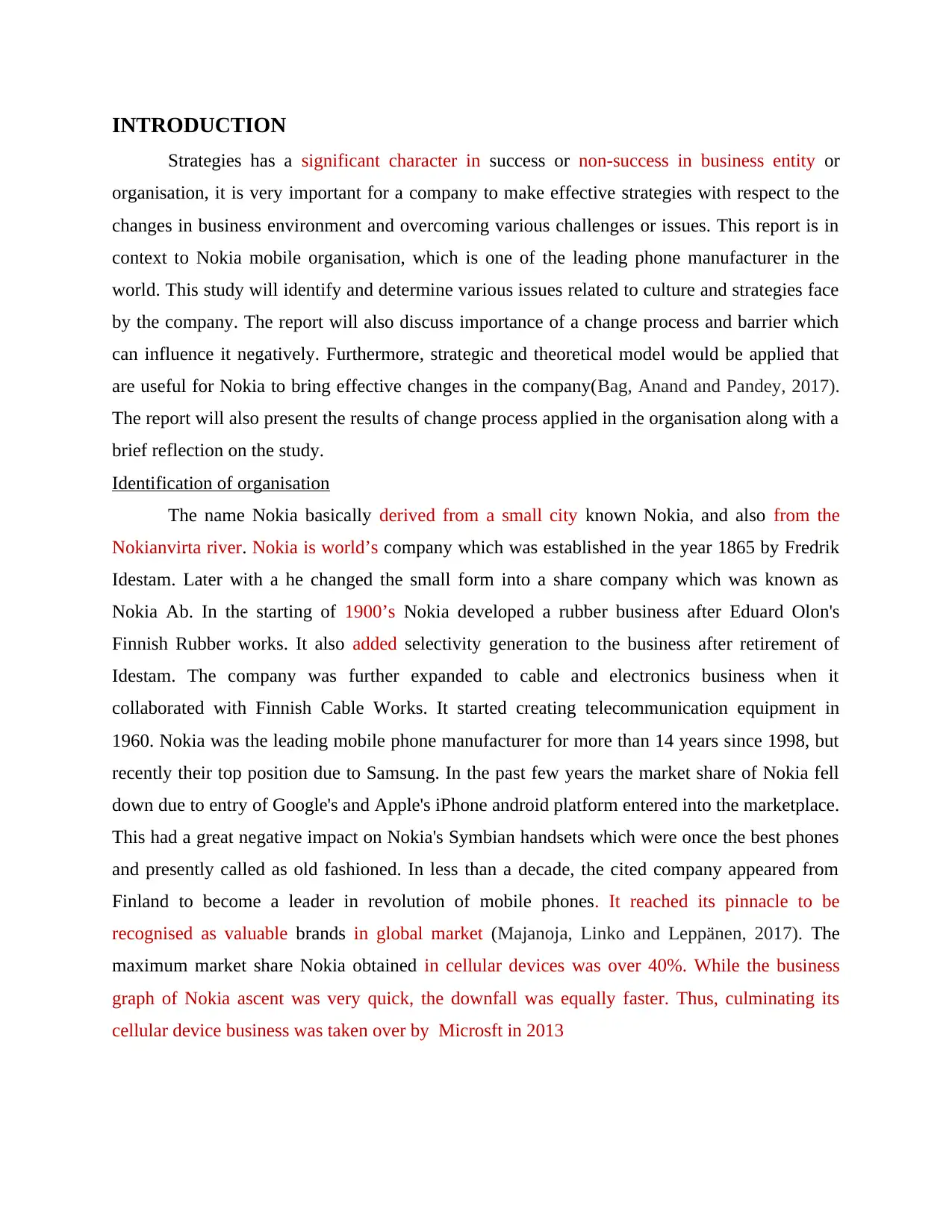
INTRODUCTION
Strategies has a significant character in success or non-success in business entity or
organisation, it is very important for a company to make effective strategies with respect to the
changes in business environment and overcoming various challenges or issues. This report is in
context to Nokia mobile organisation, which is one of the leading phone manufacturer in the
world. This study will identify and determine various issues related to culture and strategies face
by the company. The report will also discuss importance of a change process and barrier which
can influence it negatively. Furthermore, strategic and theoretical model would be applied that
are useful for Nokia to bring effective changes in the company(Bag, Anand and Pandey, 2017).
The report will also present the results of change process applied in the organisation along with a
brief reflection on the study.
Identification of organisation
The name Nokia basically derived from a small city known Nokia, and also from the
Nokianvirta river. Nokia is world’s company which was established in the year 1865 by Fredrik
Idestam. Later with a he changed the small form into a share company which was known as
Nokia Ab. In the starting of 1900’s Nokia developed a rubber business after Eduard Olon's
Finnish Rubber works. It also added selectivity generation to the business after retirement of
Idestam. The company was further expanded to cable and electronics business when it
collaborated with Finnish Cable Works. It started creating telecommunication equipment in
1960. Nokia was the leading mobile phone manufacturer for more than 14 years since 1998, but
recently their top position due to Samsung. In the past few years the market share of Nokia fell
down due to entry of Google's and Apple's iPhone android platform entered into the marketplace.
This had a great negative impact on Nokia's Symbian handsets which were once the best phones
and presently called as old fashioned. In less than a decade, the cited company appeared from
Finland to become a leader in revolution of mobile phones. It reached its pinnacle to be
recognised as valuable brands in global market (Majanoja, Linko and Leppänen, 2017). The
maximum market share Nokia obtained in cellular devices was over 40%. While the business
graph of Nokia ascent was very quick, the downfall was equally faster. Thus, culminating its
cellular device business was taken over by Microsft in 2013
Strategies has a significant character in success or non-success in business entity or
organisation, it is very important for a company to make effective strategies with respect to the
changes in business environment and overcoming various challenges or issues. This report is in
context to Nokia mobile organisation, which is one of the leading phone manufacturer in the
world. This study will identify and determine various issues related to culture and strategies face
by the company. The report will also discuss importance of a change process and barrier which
can influence it negatively. Furthermore, strategic and theoretical model would be applied that
are useful for Nokia to bring effective changes in the company(Bag, Anand and Pandey, 2017).
The report will also present the results of change process applied in the organisation along with a
brief reflection on the study.
Identification of organisation
The name Nokia basically derived from a small city known Nokia, and also from the
Nokianvirta river. Nokia is world’s company which was established in the year 1865 by Fredrik
Idestam. Later with a he changed the small form into a share company which was known as
Nokia Ab. In the starting of 1900’s Nokia developed a rubber business after Eduard Olon's
Finnish Rubber works. It also added selectivity generation to the business after retirement of
Idestam. The company was further expanded to cable and electronics business when it
collaborated with Finnish Cable Works. It started creating telecommunication equipment in
1960. Nokia was the leading mobile phone manufacturer for more than 14 years since 1998, but
recently their top position due to Samsung. In the past few years the market share of Nokia fell
down due to entry of Google's and Apple's iPhone android platform entered into the marketplace.
This had a great negative impact on Nokia's Symbian handsets which were once the best phones
and presently called as old fashioned. In less than a decade, the cited company appeared from
Finland to become a leader in revolution of mobile phones. It reached its pinnacle to be
recognised as valuable brands in global market (Majanoja, Linko and Leppänen, 2017). The
maximum market share Nokia obtained in cellular devices was over 40%. While the business
graph of Nokia ascent was very quick, the downfall was equally faster. Thus, culminating its
cellular device business was taken over by Microsft in 2013
⊘ This is a preview!⊘
Do you want full access?
Subscribe today to unlock all pages.

Trusted by 1+ million students worldwide

Key strategic issues in the organisation
There are various issues and challenges Nokia faced due to which the company lost its
position in the market and declined the profitability or shares. These issues were main reason for
the failure of the company that appeared to be a lesson for Nokia. In order to understand how the
challenges developed as well as their impact on the company's performance it is important to
determine the various issues.
1. Business tactics– Symbian Operating System has developed by Symbian Ltd., they were
joint together cellphone device manufacturer Ericsson, Nokia and Motorola and Psion.
Symbion as the most accepted operating system in smart phone on a global average till
2010 when Nokia had symbian in its all flagship phones as the operating system. In the
year 2008, Nokia took over Symbian Ltd with a strategy to develop Sybian OS as a open
source platform so that a huge number of developed can utilize it in order to improve and
create their cellular devices applications. In February 2010, it was projected as open
source code officially. But as compared to android it was very late that already a open
source and available easily and iOS has already begun to affect Symbian business with a
2
Illustration 1: Nokia Logo
(Source :Nokia Logo, 2017)
There are various issues and challenges Nokia faced due to which the company lost its
position in the market and declined the profitability or shares. These issues were main reason for
the failure of the company that appeared to be a lesson for Nokia. In order to understand how the
challenges developed as well as their impact on the company's performance it is important to
determine the various issues.
1. Business tactics– Symbian Operating System has developed by Symbian Ltd., they were
joint together cellphone device manufacturer Ericsson, Nokia and Motorola and Psion.
Symbion as the most accepted operating system in smart phone on a global average till
2010 when Nokia had symbian in its all flagship phones as the operating system. In the
year 2008, Nokia took over Symbian Ltd with a strategy to develop Sybian OS as a open
source platform so that a huge number of developed can utilize it in order to improve and
create their cellular devices applications. In February 2010, it was projected as open
source code officially. But as compared to android it was very late that already a open
source and available easily and iOS has already begun to affect Symbian business with a
2
Illustration 1: Nokia Logo
(Source :Nokia Logo, 2017)
Paraphrase This Document
Need a fresh take? Get an instant paraphrase of this document with our AI Paraphraser
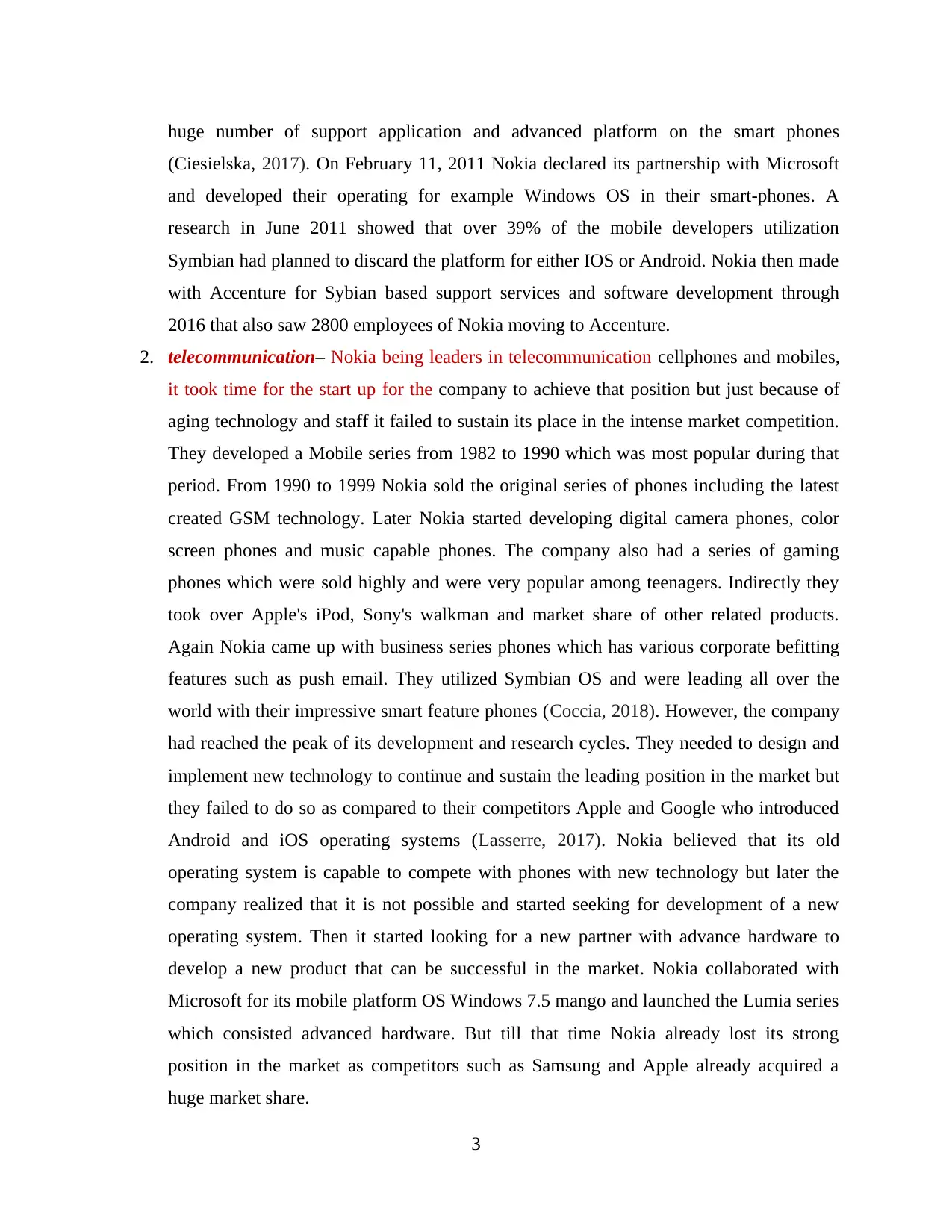
huge number of support application and advanced platform on the smart phones
(Ciesielska, 2017). On February 11, 2011 Nokia declared its partnership with Microsoft
and developed their operating for example Windows OS in their smart-phones. A
research in June 2011 showed that over 39% of the mobile developers utilization
Symbian had planned to discard the platform for either IOS or Android. Nokia then made
with Accenture for Sybian based support services and software development through
2016 that also saw 2800 employees of Nokia moving to Accenture.
2. telecommunication– Nokia being leaders in telecommunication cellphones and mobiles,
it took time for the start up for the company to achieve that position but just because of
aging technology and staff it failed to sustain its place in the intense market competition.
They developed a Mobile series from 1982 to 1990 which was most popular during that
period. From 1990 to 1999 Nokia sold the original series of phones including the latest
created GSM technology. Later Nokia started developing digital camera phones, color
screen phones and music capable phones. The company also had a series of gaming
phones which were sold highly and were very popular among teenagers. Indirectly they
took over Apple's iPod, Sony's walkman and market share of other related products.
Again Nokia came up with business series phones which has various corporate befitting
features such as push email. They utilized Symbian OS and were leading all over the
world with their impressive smart feature phones (Coccia, 2018). However, the company
had reached the peak of its development and research cycles. They needed to design and
implement new technology to continue and sustain the leading position in the market but
they failed to do so as compared to their competitors Apple and Google who introduced
Android and iOS operating systems (Lasserre, 2017). Nokia believed that its old
operating system is capable to compete with phones with new technology but later the
company realized that it is not possible and started seeking for development of a new
operating system. Then it started looking for a new partner with advance hardware to
develop a new product that can be successful in the market. Nokia collaborated with
Microsoft for its mobile platform OS Windows 7.5 mango and launched the Lumia series
which consisted advanced hardware. But till that time Nokia already lost its strong
position in the market as competitors such as Samsung and Apple already acquired a
huge market share.
3
(Ciesielska, 2017). On February 11, 2011 Nokia declared its partnership with Microsoft
and developed their operating for example Windows OS in their smart-phones. A
research in June 2011 showed that over 39% of the mobile developers utilization
Symbian had planned to discard the platform for either IOS or Android. Nokia then made
with Accenture for Sybian based support services and software development through
2016 that also saw 2800 employees of Nokia moving to Accenture.
2. telecommunication– Nokia being leaders in telecommunication cellphones and mobiles,
it took time for the start up for the company to achieve that position but just because of
aging technology and staff it failed to sustain its place in the intense market competition.
They developed a Mobile series from 1982 to 1990 which was most popular during that
period. From 1990 to 1999 Nokia sold the original series of phones including the latest
created GSM technology. Later Nokia started developing digital camera phones, color
screen phones and music capable phones. The company also had a series of gaming
phones which were sold highly and were very popular among teenagers. Indirectly they
took over Apple's iPod, Sony's walkman and market share of other related products.
Again Nokia came up with business series phones which has various corporate befitting
features such as push email. They utilized Symbian OS and were leading all over the
world with their impressive smart feature phones (Coccia, 2018). However, the company
had reached the peak of its development and research cycles. They needed to design and
implement new technology to continue and sustain the leading position in the market but
they failed to do so as compared to their competitors Apple and Google who introduced
Android and iOS operating systems (Lasserre, 2017). Nokia believed that its old
operating system is capable to compete with phones with new technology but later the
company realized that it is not possible and started seeking for development of a new
operating system. Then it started looking for a new partner with advance hardware to
develop a new product that can be successful in the market. Nokia collaborated with
Microsoft for its mobile platform OS Windows 7.5 mango and launched the Lumia series
which consisted advanced hardware. But till that time Nokia already lost its strong
position in the market as competitors such as Samsung and Apple already acquired a
huge market share.
3
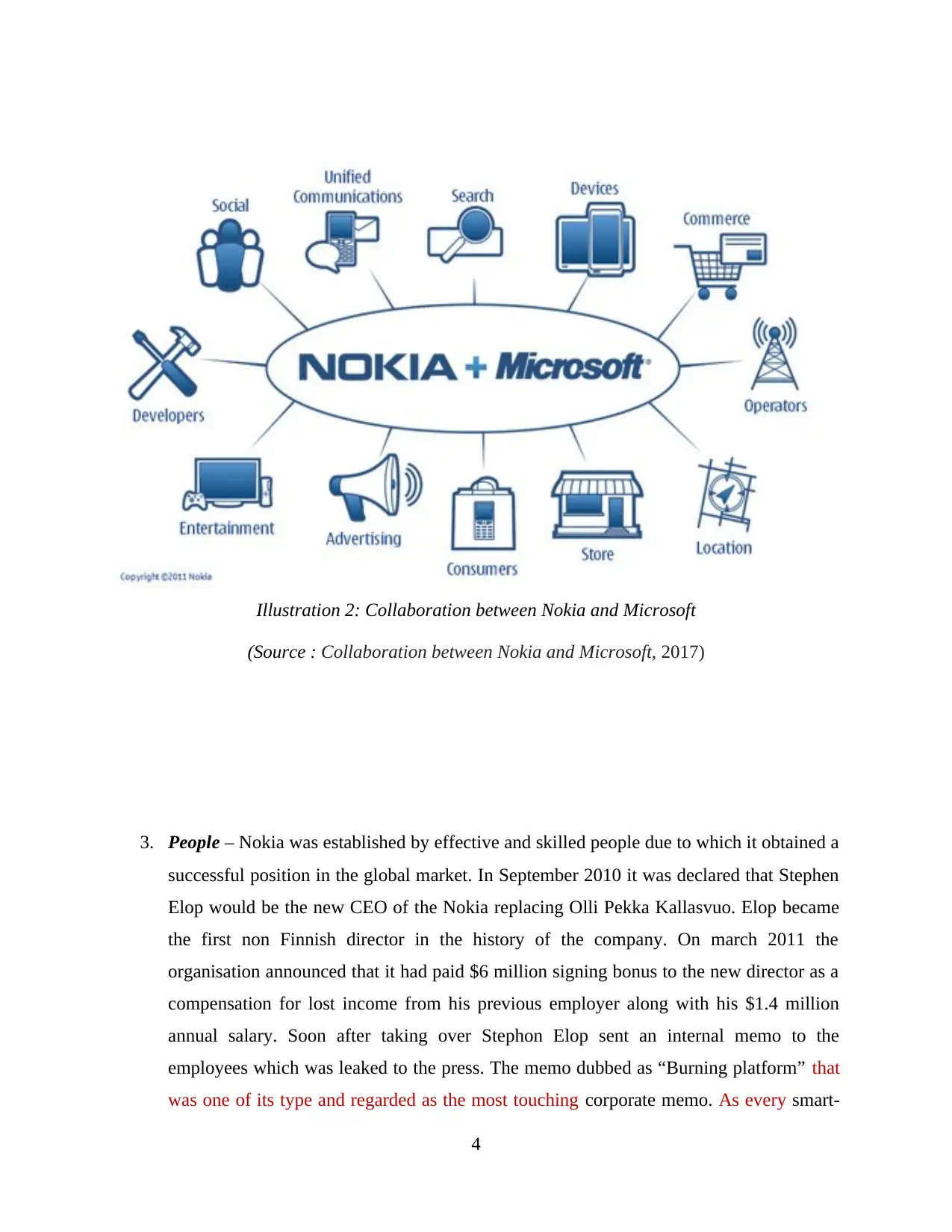
3. People – Nokia was established by effective and skilled people due to which it obtained a
successful position in the global market. In September 2010 it was declared that Stephen
Elop would be the new CEO of the Nokia replacing Olli Pekka Kallasvuo. Elop became
the first non Finnish director in the history of the company. On march 2011 the
organisation announced that it had paid $6 million signing bonus to the new director as a
compensation for lost income from his previous employer along with his $1.4 million
annual salary. Soon after taking over Stephon Elop sent an internal memo to the
employees which was leaked to the press. The memo dubbed as “Burning platform” that
was one of its type and regarded as the most touching corporate memo. As every smart-
4
Illustration 2: Collaboration between Nokia and Microsoft
(Source : Collaboration between Nokia and Microsoft, 2017)
successful position in the global market. In September 2010 it was declared that Stephen
Elop would be the new CEO of the Nokia replacing Olli Pekka Kallasvuo. Elop became
the first non Finnish director in the history of the company. On march 2011 the
organisation announced that it had paid $6 million signing bonus to the new director as a
compensation for lost income from his previous employer along with his $1.4 million
annual salary. Soon after taking over Stephon Elop sent an internal memo to the
employees which was leaked to the press. The memo dubbed as “Burning platform” that
was one of its type and regarded as the most touching corporate memo. As every smart-
4
Illustration 2: Collaboration between Nokia and Microsoft
(Source : Collaboration between Nokia and Microsoft, 2017)
⊘ This is a preview!⊘
Do you want full access?
Subscribe today to unlock all pages.

Trusted by 1+ million students worldwide
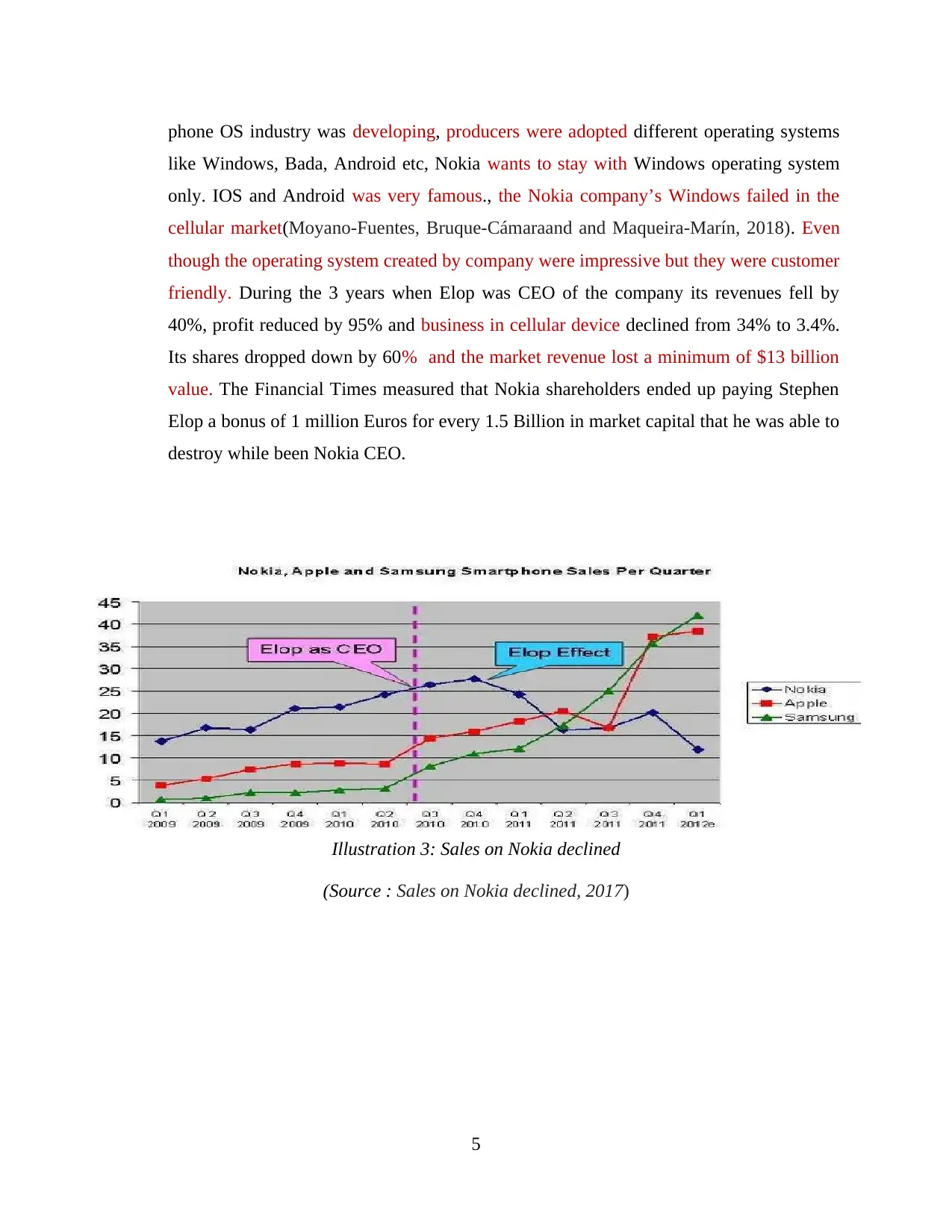
phone OS industry was developing, producers were adopted different operating systems
like Windows, Bada, Android etc, Nokia wants to stay with Windows operating system
only. IOS and Android was very famous., the Nokia company’s Windows failed in the
cellular market(Moyano-Fuentes, Bruque-Cámaraand and Maqueira-Marín, 2018). Even
though the operating system created by company were impressive but they were customer
friendly. During the 3 years when Elop was CEO of the company its revenues fell by
40%, profit reduced by 95% and business in cellular device declined from 34% to 3.4%.
Its shares dropped down by 60% and the market revenue lost a minimum of $13 billion
value. The Financial Times measured that Nokia shareholders ended up paying Stephen
Elop a bonus of 1 million Euros for every 1.5 Billion in market capital that he was able to
destroy while been Nokia CEO.
5
Illustration 3: Sales on Nokia declined
(Source : Sales on Nokia declined, 2017)
like Windows, Bada, Android etc, Nokia wants to stay with Windows operating system
only. IOS and Android was very famous., the Nokia company’s Windows failed in the
cellular market(Moyano-Fuentes, Bruque-Cámaraand and Maqueira-Marín, 2018). Even
though the operating system created by company were impressive but they were customer
friendly. During the 3 years when Elop was CEO of the company its revenues fell by
40%, profit reduced by 95% and business in cellular device declined from 34% to 3.4%.
Its shares dropped down by 60% and the market revenue lost a minimum of $13 billion
value. The Financial Times measured that Nokia shareholders ended up paying Stephen
Elop a bonus of 1 million Euros for every 1.5 Billion in market capital that he was able to
destroy while been Nokia CEO.
5
Illustration 3: Sales on Nokia declined
(Source : Sales on Nokia declined, 2017)
Paraphrase This Document
Need a fresh take? Get an instant paraphrase of this document with our AI Paraphraser
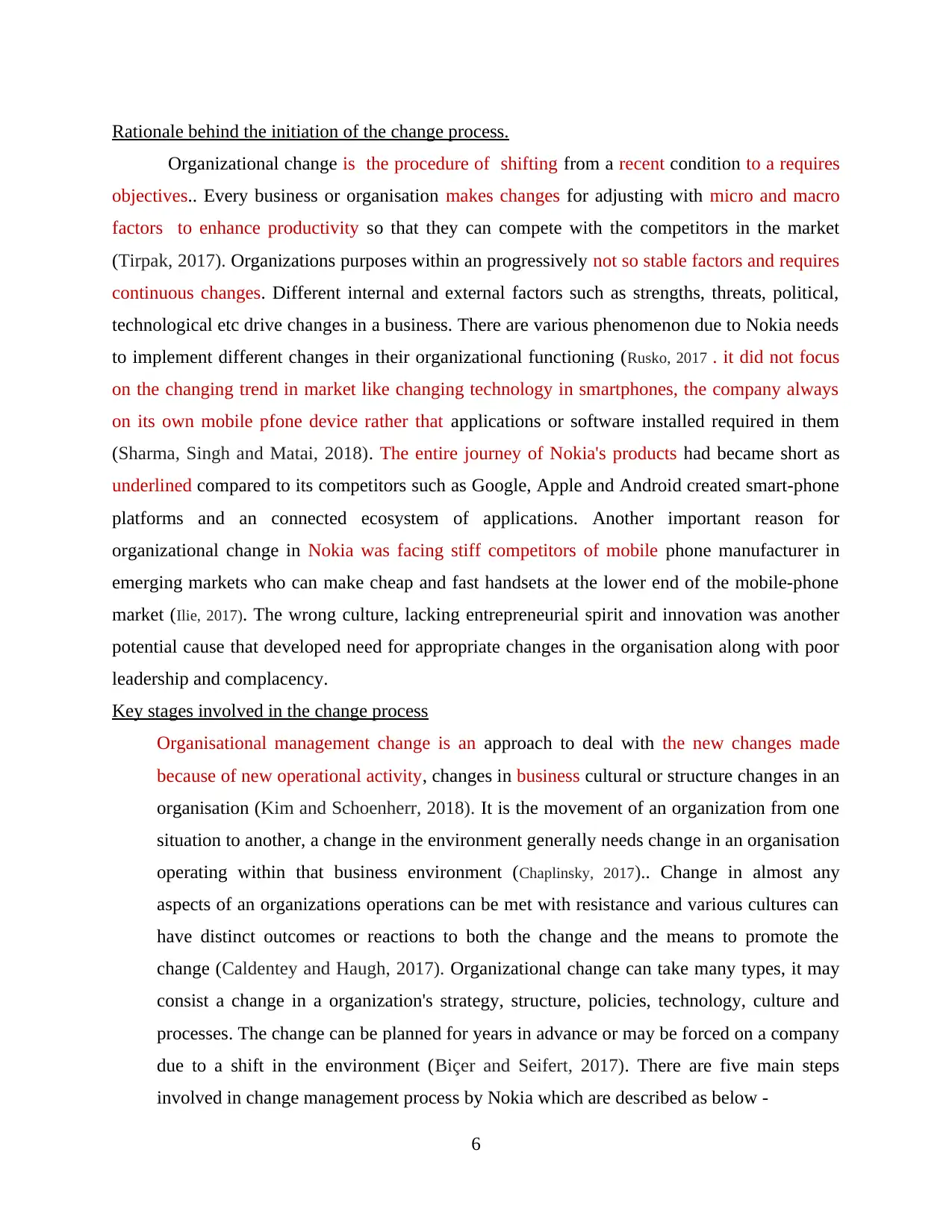
Rationale behind the initiation of the change process.
Organizational change is the procedure of shifting from a recent condition to a requires
objectives.. Every business or organisation makes changes for adjusting with micro and macro
factors to enhance productivity so that they can compete with the competitors in the market
(Tirpak, 2017). Organizations purposes within an progressively not so stable factors and requires
continuous changes. Different internal and external factors such as strengths, threats, political,
technological etc drive changes in a business. There are various phenomenon due to Nokia needs
to implement different changes in their organizational functioning (Rusko, 2017 . it did not focus
on the changing trend in market like changing technology in smartphones, the company always
on its own mobile pfone device rather that applications or software installed required in them
(Sharma, Singh and Matai, 2018). The entire journey of Nokia's products had became short as
underlined compared to its competitors such as Google, Apple and Android created smart-phone
platforms and an connected ecosystem of applications. Another important reason for
organizational change in Nokia was facing stiff competitors of mobile phone manufacturer in
emerging markets who can make cheap and fast handsets at the lower end of the mobile-phone
market (Ilie, 2017). The wrong culture, lacking entrepreneurial spirit and innovation was another
potential cause that developed need for appropriate changes in the organisation along with poor
leadership and complacency.
Key stages involved in the change process
Organisational management change is an approach to deal with the new changes made
because of new operational activity, changes in business cultural or structure changes in an
organisation (Kim and Schoenherr, 2018). It is the movement of an organization from one
situation to another, a change in the environment generally needs change in an organisation
operating within that business environment (Chaplinsky, 2017).. Change in almost any
aspects of an organizations operations can be met with resistance and various cultures can
have distinct outcomes or reactions to both the change and the means to promote the
change (Caldentey and Haugh, 2017). Organizational change can take many types, it may
consist a change in a organization's strategy, structure, policies, technology, culture and
processes. The change can be planned for years in advance or may be forced on a company
due to a shift in the environment (Biçer and Seifert, 2017). There are five main steps
involved in change management process by Nokia which are described as below -
6
Organizational change is the procedure of shifting from a recent condition to a requires
objectives.. Every business or organisation makes changes for adjusting with micro and macro
factors to enhance productivity so that they can compete with the competitors in the market
(Tirpak, 2017). Organizations purposes within an progressively not so stable factors and requires
continuous changes. Different internal and external factors such as strengths, threats, political,
technological etc drive changes in a business. There are various phenomenon due to Nokia needs
to implement different changes in their organizational functioning (Rusko, 2017 . it did not focus
on the changing trend in market like changing technology in smartphones, the company always
on its own mobile pfone device rather that applications or software installed required in them
(Sharma, Singh and Matai, 2018). The entire journey of Nokia's products had became short as
underlined compared to its competitors such as Google, Apple and Android created smart-phone
platforms and an connected ecosystem of applications. Another important reason for
organizational change in Nokia was facing stiff competitors of mobile phone manufacturer in
emerging markets who can make cheap and fast handsets at the lower end of the mobile-phone
market (Ilie, 2017). The wrong culture, lacking entrepreneurial spirit and innovation was another
potential cause that developed need for appropriate changes in the organisation along with poor
leadership and complacency.
Key stages involved in the change process
Organisational management change is an approach to deal with the new changes made
because of new operational activity, changes in business cultural or structure changes in an
organisation (Kim and Schoenherr, 2018). It is the movement of an organization from one
situation to another, a change in the environment generally needs change in an organisation
operating within that business environment (Chaplinsky, 2017).. Change in almost any
aspects of an organizations operations can be met with resistance and various cultures can
have distinct outcomes or reactions to both the change and the means to promote the
change (Caldentey and Haugh, 2017). Organizational change can take many types, it may
consist a change in a organization's strategy, structure, policies, technology, culture and
processes. The change can be planned for years in advance or may be forced on a company
due to a shift in the environment (Biçer and Seifert, 2017). There are five main steps
involved in change management process by Nokia which are described as below -
6
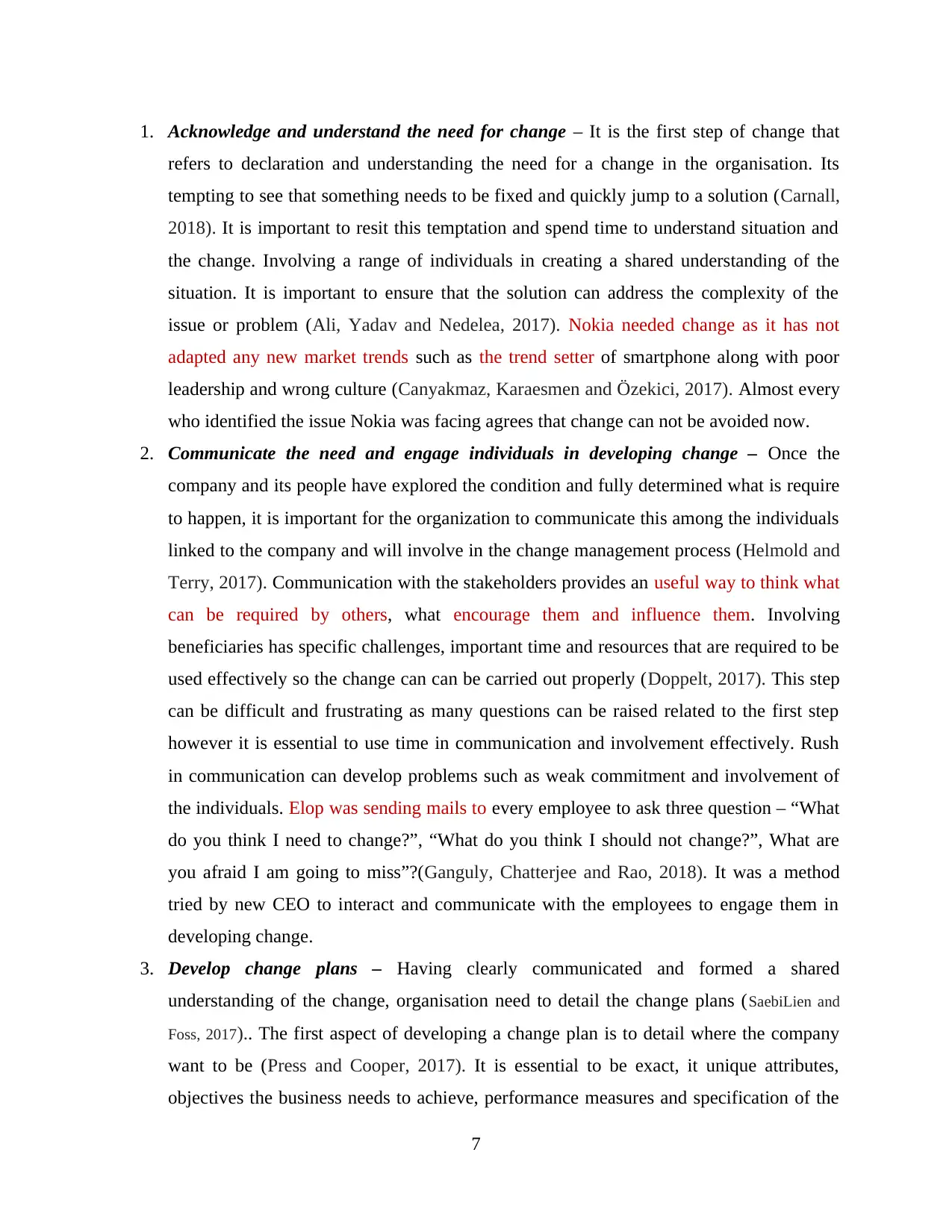
1. Acknowledge and understand the need for change – It is the first step of change that
refers to declaration and understanding the need for a change in the organisation. Its
tempting to see that something needs to be fixed and quickly jump to a solution (Carnall,
2018). It is important to resit this temptation and spend time to understand situation and
the change. Involving a range of individuals in creating a shared understanding of the
situation. It is important to ensure that the solution can address the complexity of the
issue or problem (Ali, Yadav and Nedelea, 2017). Nokia needed change as it has not
adapted any new market trends such as the trend setter of smartphone along with poor
leadership and wrong culture (Canyakmaz, Karaesmen and Özekici, 2017). Almost every
who identified the issue Nokia was facing agrees that change can not be avoided now.
2. Communicate the need and engage individuals in developing change – Once the
company and its people have explored the condition and fully determined what is require
to happen, it is important for the organization to communicate this among the individuals
linked to the company and will involve in the change management process (Helmold and
Terry, 2017). Communication with the stakeholders provides an useful way to think what
can be required by others, what encourage them and influence them. Involving
beneficiaries has specific challenges, important time and resources that are required to be
used effectively so the change can can be carried out properly (Doppelt, 2017). This step
can be difficult and frustrating as many questions can be raised related to the first step
however it is essential to use time in communication and involvement effectively. Rush
in communication can develop problems such as weak commitment and involvement of
the individuals. Elop was sending mails to every employee to ask three question – “What
do you think I need to change?”, “What do you think I should not change?”, What are
you afraid I am going to miss”?(Ganguly, Chatterjee and Rao, 2018). It was a method
tried by new CEO to interact and communicate with the employees to engage them in
developing change.
3. Develop change plans – Having clearly communicated and formed a shared
understanding of the change, organisation need to detail the change plans (SaebiLien and
Foss, 2017).. The first aspect of developing a change plan is to detail where the company
want to be (Press and Cooper, 2017). It is essential to be exact, it unique attributes,
objectives the business needs to achieve, performance measures and specification of the
7
refers to declaration and understanding the need for a change in the organisation. Its
tempting to see that something needs to be fixed and quickly jump to a solution (Carnall,
2018). It is important to resit this temptation and spend time to understand situation and
the change. Involving a range of individuals in creating a shared understanding of the
situation. It is important to ensure that the solution can address the complexity of the
issue or problem (Ali, Yadav and Nedelea, 2017). Nokia needed change as it has not
adapted any new market trends such as the trend setter of smartphone along with poor
leadership and wrong culture (Canyakmaz, Karaesmen and Özekici, 2017). Almost every
who identified the issue Nokia was facing agrees that change can not be avoided now.
2. Communicate the need and engage individuals in developing change – Once the
company and its people have explored the condition and fully determined what is require
to happen, it is important for the organization to communicate this among the individuals
linked to the company and will involve in the change management process (Helmold and
Terry, 2017). Communication with the stakeholders provides an useful way to think what
can be required by others, what encourage them and influence them. Involving
beneficiaries has specific challenges, important time and resources that are required to be
used effectively so the change can can be carried out properly (Doppelt, 2017). This step
can be difficult and frustrating as many questions can be raised related to the first step
however it is essential to use time in communication and involvement effectively. Rush
in communication can develop problems such as weak commitment and involvement of
the individuals. Elop was sending mails to every employee to ask three question – “What
do you think I need to change?”, “What do you think I should not change?”, What are
you afraid I am going to miss”?(Ganguly, Chatterjee and Rao, 2018). It was a method
tried by new CEO to interact and communicate with the employees to engage them in
developing change.
3. Develop change plans – Having clearly communicated and formed a shared
understanding of the change, organisation need to detail the change plans (SaebiLien and
Foss, 2017).. The first aspect of developing a change plan is to detail where the company
want to be (Press and Cooper, 2017). It is essential to be exact, it unique attributes,
objectives the business needs to achieve, performance measures and specification of the
7
⊘ This is a preview!⊘
Do you want full access?
Subscribe today to unlock all pages.

Trusted by 1+ million students worldwide
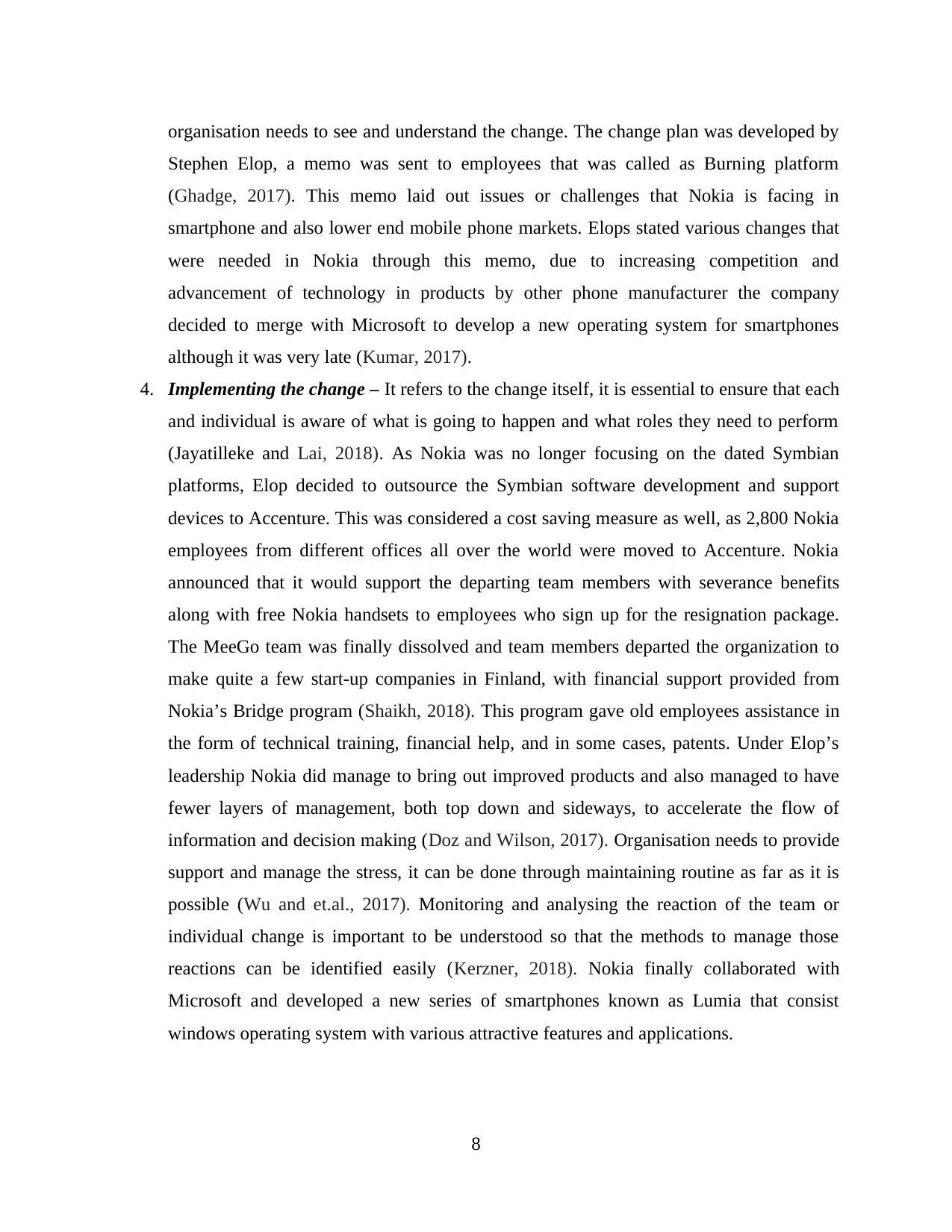
organisation needs to see and understand the change. The change plan was developed by
Stephen Elop, a memo was sent to employees that was called as Burning platform
(Ghadge, 2017). This memo laid out issues or challenges that Nokia is facing in
smartphone and also lower end mobile phone markets. Elops stated various changes that
were needed in Nokia through this memo, due to increasing competition and
advancement of technology in products by other phone manufacturer the company
decided to merge with Microsoft to develop a new operating system for smartphones
although it was very late (Kumar, 2017).
4. Implementing the change – It refers to the change itself, it is essential to ensure that each
and individual is aware of what is going to happen and what roles they need to perform
(Jayatilleke and Lai, 2018). As Nokia was no longer focusing on the dated Symbian
platforms, Elop decided to outsource the Symbian software development and support
devices to Accenture. This was considered a cost saving measure as well, as 2,800 Nokia
employees from different offices all over the world were moved to Accenture. Nokia
announced that it would support the departing team members with severance benefits
along with free Nokia handsets to employees who sign up for the resignation package.
The MeeGo team was finally dissolved and team members departed the organization to
make quite a few start-up companies in Finland, with financial support provided from
Nokia’s Bridge program (Shaikh, 2018). This program gave old employees assistance in
the form of technical training, financial help, and in some cases, patents. Under Elop’s
leadership Nokia did manage to bring out improved products and also managed to have
fewer layers of management, both top down and sideways, to accelerate the flow of
information and decision making (Doz and Wilson, 2017). Organisation needs to provide
support and manage the stress, it can be done through maintaining routine as far as it is
possible (Wu and et.al., 2017). Monitoring and analysing the reaction of the team or
individual change is important to be understood so that the methods to manage those
reactions can be identified easily (Kerzner, 2018). Nokia finally collaborated with
Microsoft and developed a new series of smartphones known as Lumia that consist
windows operating system with various attractive features and applications.
8
Stephen Elop, a memo was sent to employees that was called as Burning platform
(Ghadge, 2017). This memo laid out issues or challenges that Nokia is facing in
smartphone and also lower end mobile phone markets. Elops stated various changes that
were needed in Nokia through this memo, due to increasing competition and
advancement of technology in products by other phone manufacturer the company
decided to merge with Microsoft to develop a new operating system for smartphones
although it was very late (Kumar, 2017).
4. Implementing the change – It refers to the change itself, it is essential to ensure that each
and individual is aware of what is going to happen and what roles they need to perform
(Jayatilleke and Lai, 2018). As Nokia was no longer focusing on the dated Symbian
platforms, Elop decided to outsource the Symbian software development and support
devices to Accenture. This was considered a cost saving measure as well, as 2,800 Nokia
employees from different offices all over the world were moved to Accenture. Nokia
announced that it would support the departing team members with severance benefits
along with free Nokia handsets to employees who sign up for the resignation package.
The MeeGo team was finally dissolved and team members departed the organization to
make quite a few start-up companies in Finland, with financial support provided from
Nokia’s Bridge program (Shaikh, 2018). This program gave old employees assistance in
the form of technical training, financial help, and in some cases, patents. Under Elop’s
leadership Nokia did manage to bring out improved products and also managed to have
fewer layers of management, both top down and sideways, to accelerate the flow of
information and decision making (Doz and Wilson, 2017). Organisation needs to provide
support and manage the stress, it can be done through maintaining routine as far as it is
possible (Wu and et.al., 2017). Monitoring and analysing the reaction of the team or
individual change is important to be understood so that the methods to manage those
reactions can be identified easily (Kerzner, 2018). Nokia finally collaborated with
Microsoft and developed a new series of smartphones known as Lumia that consist
windows operating system with various attractive features and applications.
8
Paraphrase This Document
Need a fresh take? Get an instant paraphrase of this document with our AI Paraphraser
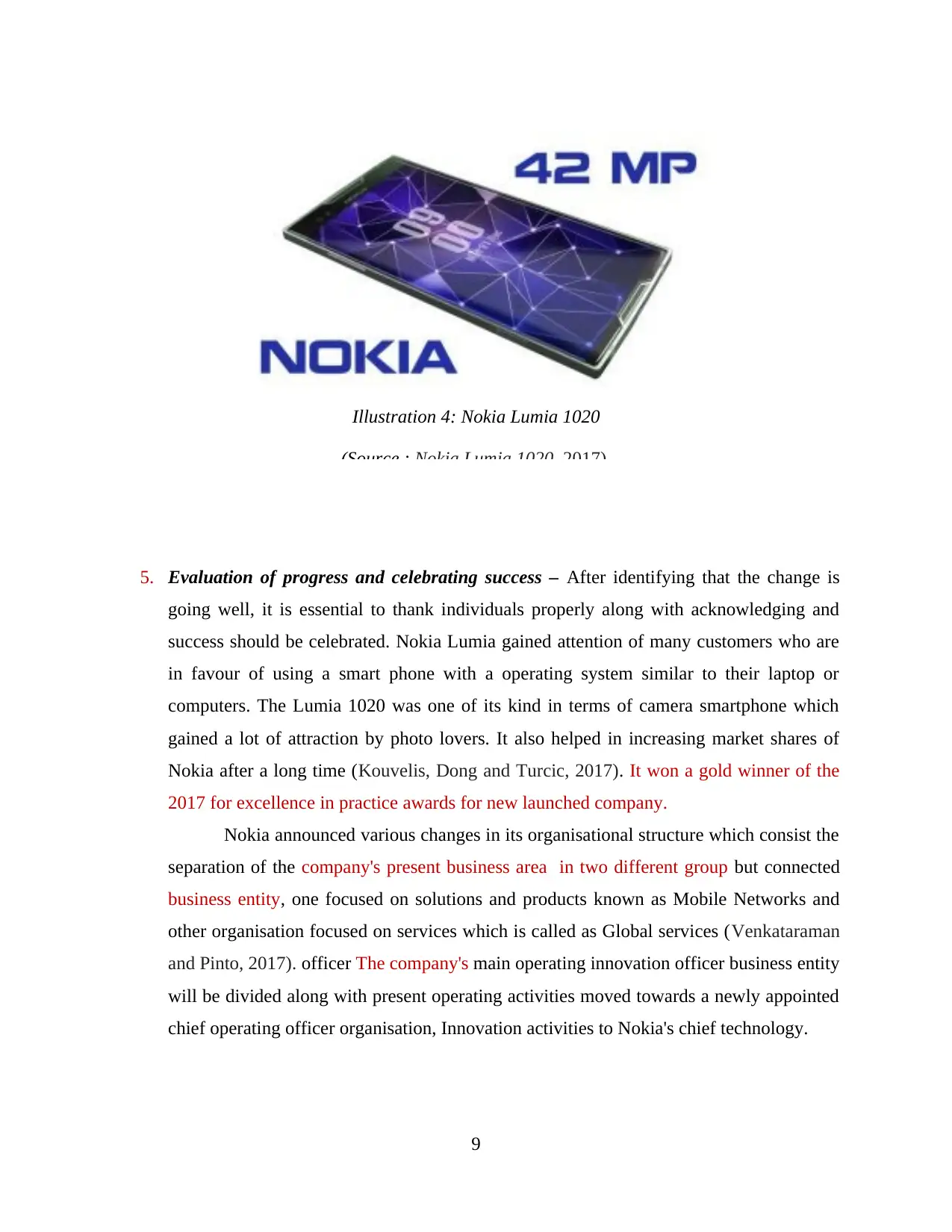
5. Evaluation of progress and celebrating success – After identifying that the change is
going well, it is essential to thank individuals properly along with acknowledging and
success should be celebrated. Nokia Lumia gained attention of many customers who are
in favour of using a smart phone with a operating system similar to their laptop or
computers. The Lumia 1020 was one of its kind in terms of camera smartphone which
gained a lot of attraction by photo lovers. It also helped in increasing market shares of
Nokia after a long time (Kouvelis, Dong and Turcic, 2017). It won a gold winner of the
2017 for excellence in practice awards for new launched company.
Nokia announced various changes in its organisational structure which consist the
separation of the company's present business area in two different group but connected
business entity, one focused on solutions and products known as Mobile Networks and
other organisation focused on services which is called as Global services (Venkataraman
and Pinto, 2017). officer The company's main operating innovation officer business entity
will be divided along with present operating activities moved towards a newly appointed
chief operating officer organisation, Innovation activities to Nokia's chief technology.
9
Illustration 4: Nokia Lumia 1020
(Source : Nokia Lumia 1020, 2017).
going well, it is essential to thank individuals properly along with acknowledging and
success should be celebrated. Nokia Lumia gained attention of many customers who are
in favour of using a smart phone with a operating system similar to their laptop or
computers. The Lumia 1020 was one of its kind in terms of camera smartphone which
gained a lot of attraction by photo lovers. It also helped in increasing market shares of
Nokia after a long time (Kouvelis, Dong and Turcic, 2017). It won a gold winner of the
2017 for excellence in practice awards for new launched company.
Nokia announced various changes in its organisational structure which consist the
separation of the company's present business area in two different group but connected
business entity, one focused on solutions and products known as Mobile Networks and
other organisation focused on services which is called as Global services (Venkataraman
and Pinto, 2017). officer The company's main operating innovation officer business entity
will be divided along with present operating activities moved towards a newly appointed
chief operating officer organisation, Innovation activities to Nokia's chief technology.
9
Illustration 4: Nokia Lumia 1020
(Source : Nokia Lumia 1020, 2017).
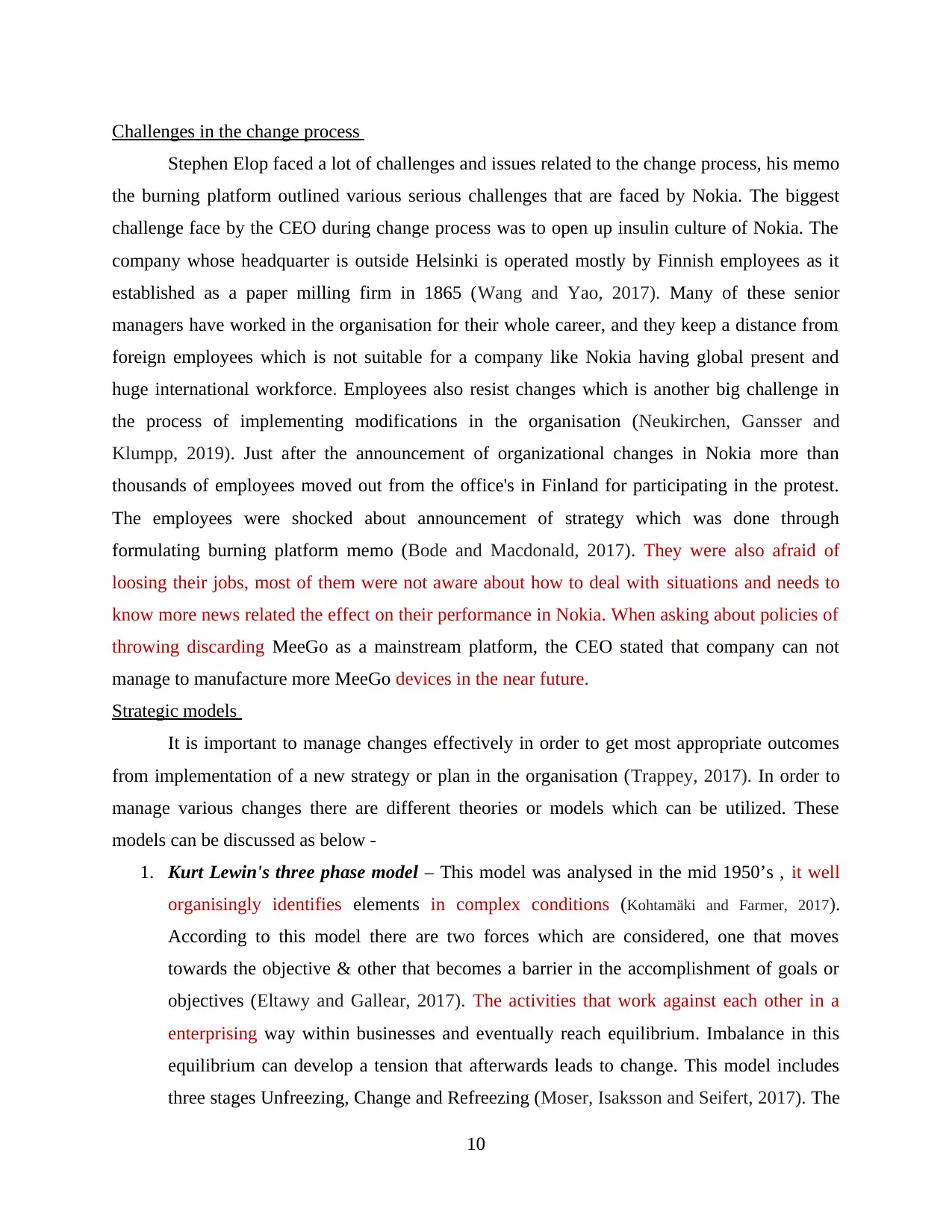
Challenges in the change process
Stephen Elop faced a lot of challenges and issues related to the change process, his memo
the burning platform outlined various serious challenges that are faced by Nokia. The biggest
challenge face by the CEO during change process was to open up insulin culture of Nokia. The
company whose headquarter is outside Helsinki is operated mostly by Finnish employees as it
established as a paper milling firm in 1865 (Wang and Yao, 2017). Many of these senior
managers have worked in the organisation for their whole career, and they keep a distance from
foreign employees which is not suitable for a company like Nokia having global present and
huge international workforce. Employees also resist changes which is another big challenge in
the process of implementing modifications in the organisation (Neukirchen, Gansser and
Klumpp, 2019). Just after the announcement of organizational changes in Nokia more than
thousands of employees moved out from the office's in Finland for participating in the protest.
The employees were shocked about announcement of strategy which was done through
formulating burning platform memo (Bode and Macdonald, 2017). They were also afraid of
loosing their jobs, most of them were not aware about how to deal with situations and needs to
know more news related the effect on their performance in Nokia. When asking about policies of
throwing discarding MeeGo as a mainstream platform, the CEO stated that company can not
manage to manufacture more MeeGo devices in the near future.
Strategic models
It is important to manage changes effectively in order to get most appropriate outcomes
from implementation of a new strategy or plan in the organisation (Trappey, 2017). In order to
manage various changes there are different theories or models which can be utilized. These
models can be discussed as below -
1. Kurt Lewin's three phase model – This model was analysed in the mid 1950’s , it well
organisingly identifies elements in complex conditions (Kohtamäki and Farmer, 2017).
According to this model there are two forces which are considered, one that moves
towards the objective & other that becomes a barrier in the accomplishment of goals or
objectives (Eltawy and Gallear, 2017). The activities that work against each other in a
enterprising way within businesses and eventually reach equilibrium. Imbalance in this
equilibrium can develop a tension that afterwards leads to change. This model includes
three stages Unfreezing, Change and Refreezing (Moser, Isaksson and Seifert, 2017). The
10
Stephen Elop faced a lot of challenges and issues related to the change process, his memo
the burning platform outlined various serious challenges that are faced by Nokia. The biggest
challenge face by the CEO during change process was to open up insulin culture of Nokia. The
company whose headquarter is outside Helsinki is operated mostly by Finnish employees as it
established as a paper milling firm in 1865 (Wang and Yao, 2017). Many of these senior
managers have worked in the organisation for their whole career, and they keep a distance from
foreign employees which is not suitable for a company like Nokia having global present and
huge international workforce. Employees also resist changes which is another big challenge in
the process of implementing modifications in the organisation (Neukirchen, Gansser and
Klumpp, 2019). Just after the announcement of organizational changes in Nokia more than
thousands of employees moved out from the office's in Finland for participating in the protest.
The employees were shocked about announcement of strategy which was done through
formulating burning platform memo (Bode and Macdonald, 2017). They were also afraid of
loosing their jobs, most of them were not aware about how to deal with situations and needs to
know more news related the effect on their performance in Nokia. When asking about policies of
throwing discarding MeeGo as a mainstream platform, the CEO stated that company can not
manage to manufacture more MeeGo devices in the near future.
Strategic models
It is important to manage changes effectively in order to get most appropriate outcomes
from implementation of a new strategy or plan in the organisation (Trappey, 2017). In order to
manage various changes there are different theories or models which can be utilized. These
models can be discussed as below -
1. Kurt Lewin's three phase model – This model was analysed in the mid 1950’s , it well
organisingly identifies elements in complex conditions (Kohtamäki and Farmer, 2017).
According to this model there are two forces which are considered, one that moves
towards the objective & other that becomes a barrier in the accomplishment of goals or
objectives (Eltawy and Gallear, 2017). The activities that work against each other in a
enterprising way within businesses and eventually reach equilibrium. Imbalance in this
equilibrium can develop a tension that afterwards leads to change. This model includes
three stages Unfreezing, Change and Refreezing (Moser, Isaksson and Seifert, 2017). The
10
⊘ This is a preview!⊘
Do you want full access?
Subscribe today to unlock all pages.

Trusted by 1+ million students worldwide
1 out of 24
Related Documents
Your All-in-One AI-Powered Toolkit for Academic Success.
+13062052269
info@desklib.com
Available 24*7 on WhatsApp / Email
![[object Object]](/_next/static/media/star-bottom.7253800d.svg)
Unlock your academic potential
Copyright © 2020–2025 A2Z Services. All Rights Reserved. Developed and managed by ZUCOL.





